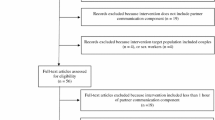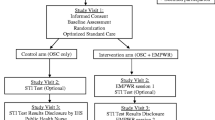Abstract
Background
Chinese monogamous women may contract sexually transmitted diseases (STD) from their sole male sex partner, but these women do not have high self-efficacy in negotiating about condom use with their regular sex partners.
Purpose
We aim to investigate the relative efficacy of a theory-based and clinic-based cognitive behavioral intervention versus a control intervention in increasing prevalence of condom use with their male sex partner among Chinese monogamous female sexually transmitted disease patients.
Methods
A randomized controlled trial (RCT) was conducted. Participants were randomly allocated into the intervention group (n = 88) or the control group (n = 88). All participants were phone interviewed at baseline and at 2 and 3 months after completion of the baseline survey. The three-session group intervention was based on the information–motivation–behavioral skills (IMB) model. Participants of the control group were provided with educational pamphlets. The primary outcome was consistent condom use in the last month. Relative risks were calculated, and multiple logistic regression models were fit.
Results
As compared to the control group, the intervention group reported higher prevalence of consistent condom use with the sole male sex partner in the last month at month 2 (75.3 versus 59.8 %, RR = 1.26, 95 % CI = 1.01, 1.57) and month 3 (77.8 versus 54.6 %, RR = 1.42, 95 % CI = 1.13, 1.80), whilst the baseline between-group difference was statistically non-significant. Some other secondary outcomes such as “intention to request condom use in the next month even if the sexual partner dislikes using condoms” were also statistically significant. Furthermore, the majority (94 %) of the intervention group members were satisfied with the intervention.
Conclusions
The theory-based intervention is potentially efficacious, but the follow-up period was relatively short. Large-scale randomized clinical trials and subsequent translational research are greatly warranted in the future.


Similar content being viewed by others
References
O'Leary A. Women at risk for HIV from a primary partner: balancing risk and intimacy. Annu Rev Sex Res. 2000;11:191–234.
Espirito Santo ME G d, Etheredge GD. Male clients of brothel prostitutes as a bridge for HIV infection between high risk and low risk groups of women in Senegal. Sex Transm Infect. 2005;81(4):342–4. doi:10.1136/sti.2004.011940.
Hor LB, Detels R, Heng S, Mun P. The role of sex worker clients in transmission of HIV in Cambodia. Int J STD AIDS. 2005;16(2):170–4. doi:10.1258/0956462053057567.
Lowndes CM, Alary M, Meda H, Gnintoungbe CA, Mukenge-Tshibaka L, Adjovi C, et al. Role of core and bridging groups in the transmission dynamics of HIV and STIs in Cotonou, Benin, West Africa. Sex Transm Infect. 2002;78 Suppl 1:i69–77.
Lau JT, Ho SP, Yang X, Wong E, Tsui HY, Ho KM. Prevalence of HIV and factors associated with risk behaviours among Chinese female sex workers in Hong Kong. AIDS Care. 2007;19(6):721–32. doi:10.1080/09540120601084373.
Lau JT, Gu J, Tsui HY, Chen H, Holroyd E, Wang R, et al. Prevalence and associated factors of condom use during commercial sex by female sex workers who were or were not injecting drug users in China. Sex Health. 2012;9(4):368–76. doi:10.1071/sh11108.
Yang C, Latkin C, Luan R, Wang C, Nelson K. HIV, syphilis, hepatitis C and risk behaviours among commercial sex male clients in Sichuan province, China. Sex Transm Infect. 2010;86(7):559–64. doi:10.1136/sti.2009.041731.
Zhang C, Li X, Hong Y, Zhou Y, Liu W, Stanton B. Unprotected sex with their clients among low-paying female sex workers in southwest China. AIDS Care. 2012. doi:10.1080/09540121.2012.726345.
Choe HS, Lee DS, Lee SJ, Lee CB, Lee WC, Cho YH. Prevalence of sexually transmitted infections and sexual behavior of young adults and middle-aged people presenting to health examination centers in Korea. J Infect Chemother. 2012;18(2):207–12. doi:10.1007/s10156-011-0319-x.
Dai S, Shen Z, Zha Z, Leng R, Qin W, Wang C, et al. Seroprevalence of HIV, syphilis, and hepatitis C virus in the general population of the Liangshan Prefecture, Sichuan Province, China. J Med Virol. 2012;84(1):1–5. doi:10.1002/jmv.22214.
Wang J, Jiang B, Siegal H, Falck R, Carlson R. Sexual behavior and condom use among patients with sexually transmitted diseases in Jinan, China. Am J Public Health. 2001;91(4):650–1.
Lau JT, Wang M, Wong HN, Tsui HY, Jia M, Cheng F, et al. Prevalence of bisexual behaviors among men who have sex with men (MSM) in China and associations between condom use in MSM and heterosexual behaviors. Sex Transm Dis. 2008;35(4):406–13. doi:10.1097/OLQ.0b013e318164467f.
Roye CF. Condom use by Hispanic and African-American adolescent girls who use hormonal contraception. J Adolesc Health. 1998;23(4):205–11.
Lau JT, Tang AS, Siah PC, Tsui HY. Assessment of HIV-related sexual risk behaviors among the general female population in Hong Kong. Arch Sex Behav. 2002;31(6):535–42.
Abdullah AS, Fielding R, Hedley AJ, Ebrahim SH, Luk YK. Reasons for not using condoms among the Hong Kong Chinese population: implications for HIV and STD prevention. Sex Transm Infect. 2002;78(3):180–4.
Mizuno Y, Purcell DW, Latka MH, Metsch LR, Gomez CA, Latkin CA. Beliefs that condoms reduce sexual pleasure-gender differences in correlates among heterosexual HIV-positive injection drug users (IDUs). J Urban Health. 2007;84(4):523–36. doi:10.1007/s11524-007-9162-x.
Decker MR, Miller E, Raj A, Saggurti N, Donta B, Silverman JG. Indian men's use of commercial sex workers: prevalence, condom use, and related gender attitudes. J Acquir Immune Defic Syndr. 2010;53(2):240–6. doi:10.1097/QAI.0b013e3181c2fb2e.
Dunkle KL, Jewkes RK, Brown HC, Gray GE, McIntryre JA, Harlow SD. Gender-based violence, relationship power, and risk of HIV infection in women attending antenatal clinics in South Africa. Lancet. 2004;363(9419):1415–21. doi:10.1016/s0140-6736(04)16098-4.
Chen TY, Tang CS. Stress appraisal and social support of Chinese mothers of adult children with mental retardation. Am J Ment Retard. 1997;101(5):473–82.
Goodwin R, Tang C. Chinese personal relationship. In: Bond MH, editor. Handbook of Chinese psychology. Hong Kong: Oxford University Press; 1996. p. 294–308.
Varga CA. The condom conundrum: barriers to condom use among commercial sex workers in Durban, South Africa. Afr J Reprod Health. 1997;1(1):74–88.
Pettifor A, Turner AN, Swezey T, Khan M, Raharinivo MS, Randrianasolo B, et al. Perceived control over condom use among sex workers in Madagascar: a cohort study. BMC Womens Health. 2010;10:4. doi:10.1186/1472-6874-10-4.
You H, Lau JT, Gu J, Tsui HY, Wang Z, Kim JH. Awareness and acceptability of female condoms among monogamous Hong Kong Chinese female sexually transmitted infection patients. AIDS Behav. 2012. doi:10.1007/s10461-012-0376-x.
Desgrees-Du-Lou A, Brou H, Djohan G, Becquet R, Ekouevi DK, Zanou B, et al. Beneficial effects of offering prenatal HIV counselling and testing on developing a HIV preventive attitude among couples. Abidjan, 2002–2005. AIDS Behav. 2009;13(2):348–55.
Rou K, Wu Z, Sullivan SG, Li F, Guan J, Xu C, et al. A five-city trial of a behavioural intervention to reduce sexually transmitted disease/HIV risk among sex workers in China. AIDS. 2007;21 Suppl 8:S95–101. doi:10.1097/01.aids.0000304703.77755.c7.
Warner L, Klausner JD, Rietmeijer CA, Malotte CK, O'Donnell L, Margolis AD, et al. Effect of a brief video intervention on incident infection among patients attending sexually transmitted disease clinics. PLoS Med. 2008;5(6):e135. doi:10.1371/journal.pmed.0050135.
Cohen DA, MacKinnon DP, Dent C, Mason HR, Sullivan E. Group counseling at STD clinics to promote use of condoms. Public Health Rep. 1992;107(6):727–31.
Lowndes CM, Alary M, Labbe AC, Gnintoungbe C, Belleau M, Mukenge L, et al. Interventions among male clients of female sex workers in Benin, West Africa: an essential component of targeted HIV preventive interventions. Sex Transm Infect. 2007;83(7):577–81. doi:10.1136/sti.2007.027441.
Ramesh BM, Beattie TS, Shajy I, Washington R, Jagannathan L, Reza-Paul S, et al. Changes in risk behaviours and prevalence of sexually transmitted infections following HIV preventive interventions among female sex workers in five districts in Karnataka state, South India. Sex Transm Infect. 2010;86 Suppl 1:i17–24. doi:10.1136/sti.2009.038513.
Lau JT, Wang R, Chen H, Gu J, Zhang J, Cheng F, et al. Evaluation of the overall program effectiveness of HIV-related intervention programs in a community in Sichuan, China. Sex Transm Dis. 2007;34(9):653–62. doi:10.1097/01.olq.0000260948.10572.b9.
Phillips B, Ball C, Badenoch D, Straus S, Haynes B, Dawes M. Levels of evidence. BJU Int. 2010;105(9):1351.
Gardner B, Whittington C, McAteer J, Eccles MP, Michie S. Using theory to synthesise evidence from behaviour change interventions: the example of audit and feedback. Soc Sci Med. 2010;70(10):1618–25. doi:10.1016/j.socscimed.2010.01.039.
Fisher JD, Fisher WA. Changing AIDS-risk behavior. Psychol Bull. 1992;111(3):455–74.
Fisher JD, Fisher WA, Misovich SJ, Kimble DL, Malloy TE. Changing AIDS risk behavior: effects of an intervention emphasizing AIDS risk reduction information, motivation, and behavioral skills in a college student population. Health Psychol. 1996;15(2):114–23.
Wang K, Lee AH, Hamilton G, Yau KK. Multilevel logistic regression modelling with correlated random effects: application to the smoking cessation for youth study. Stat Med. 2006;25(22):3864–76. doi:10.1002/sim.2472.
Yan J, Lau JT, Tsui HY, Gu J, Wang Z. Prevalence and factors associated with condom use among Chinese monogamous female patients with sexually transmitted infection in Hong Kong. J Sex Med. 2012;9(12):3009–17. doi:10.1111/j.1743-6109.2012.02945.x.
Lau JT, Cai W, Tsui HY, Cheng J, Chen L, Choi KC, et al. Prevalence and correlates of unprotected anal intercourse among Hong Kong men who have sex with men traveling to Shenzhen, China. AIDS Behav. 2012. doi:10.1007/s10461-012-0244-8.
Xiao Z. Correlates of condom use among Chinese college students in Hunan province. AIDS Educ Prev. 2012;24(5):469–82. doi:10.1521/aeap.2012.24.5.469.
Zhao J, Song F, Ren S, Wang Y, Wang L, Liu W, et al. Predictors of condom use behaviors based on the health belief model (HBM) among female sex workers: a cross-sectional study in Hubei province, China. PLoS One. 2012;7(11):e49542. doi:10.1371/journal.pone.0049542.
Fisher JD, Fisher WA. Theoretical approaches to individual-level change in HIV risk behaviour. In: Peterson JL, DiClemente RJ, editors. Handbook of HIV Prevention. New York: Kluwer Academic/Plenum Publishers; 2000. p. 3–55.
Glanz K, Rimer BK, Viswanath K. Health behavior and health education: theory, research, and practice. 4th ed. San Francisco: Jossey-Bass; 2008.
Noar SM. Behavioral interventions to reduce HIV-related sexual risk behavior: review and synthesis of meta-analytic evidence. AIDS Behav. 2008;12(3):335–53. doi:10.1007/s10461-007-9313-9.
Boyer CB, Shafer MA, Shaffer RA, Brodine SK, Pollack LM, Betsinger K, et al. Evaluation of a cognitive-behavioral, group, randomized controlled intervention trial to prevent sexually transmitted infections and unintended pregnancies in young women. Prev Med. 2005;40(4):420–31. doi:10.1016/j.ypmed.2004.07.004.
Carey MP, Maisto SA, Kalichman SC, Forsyth AD, Wright EM, Johnson BT. Enhancing motivation to reduce the risk of HIV infection for economically disadvantaged urban women. J Consult Clin Psychol. 1997;65(4):531–41.
Kalichman SC, Cain D, Weinhardt L, Benotsch E, Presser K, Zweben A, et al. Experimental components analysis of brief theory-based HIV/AIDS risk-reduction counseling for sexually transmitted infection patients. Health Psychol. 2005;24(2):198–208. doi:10.1037/0278-6133.24.2.198.
Laven H. Self-reported data may be unreliable. J Prim Health Care. 2012;4(4):350–1.
Strite SA, Stuart ME. Importance of blinding in randomized trials. JAMA. 2010;304(19):2127–8. doi:10.1001/jama.2010.1621. author reply 8.
Acknowledgments
The authors gratefully thank the study participants for their contribution and the Department of Health for its support. This study was financially supported by The Hong Kong Council for the AIDS Trust Fund.
Conflict of interest
We declare that we have no conflict of interest.
Author information
Authors and Affiliations
Corresponding author
Rights and permissions
About this article
Cite this article
Lau, J.T.F., Li, J., Choi, K.C. et al. A Randomized Controlled Trial Evaluating the Efficacy of a Theory-based Intervention Promoting Condom Use Among Chinese Monogamous Female Sexually Transmitted Infection Patients. Int.J. Behav. Med. 21, 719–729 (2014). https://doi.org/10.1007/s12529-014-9388-4
Published:
Issue Date:
DOI: https://doi.org/10.1007/s12529-014-9388-4




